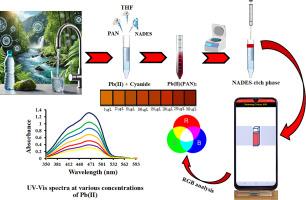Ultrasound-assisted DLLME with natural deep eutectic solvent and smartphone-based colorimetry for Pb(II) detection in water
IF 4.9
Q1 CHEMISTRY, ANALYTICAL
引用次数: 0
Abstract
This research presents a novel, cost-efficient and high-performance method for preconcentration and detection of lead ions [Pb(II)] using ultrasound-assisted dispersive liquid-liquid microextraction (USA-DLLME) combined with digital image colorimetry (DIC). The extraction phase included a natural deep eutectic solvent (NADES) made from choline chloride and thymol. The digital colorimetric analysis is based on the color transition of the Pb(II)[1-(2-pyridylazo)-2-naphthol (PAN)]2 complex, which changes from orange to wine red color in ethanol. The images of the NADES solution containing Pb(II) complex were captured using an Android smartphone and processed with the Color Grab application. Under the optimum conditions, a calibration curve for Pb(II) was constructed using the green channel intensity over the concentration range of 10 to 300 ng/mL, yielding a strong linear correlation (R2 = 0.9929). The detection limit and quantification limit were determined as 5.21 ng/mL and 17.38 ng/mL, respectively. The method demonstrated good precision with relative standard deviations (RSD) of 1.02 % within a single day and 1.25 % across multiple days. Finally, the current method was successfully applied to quantify the Pb(II) in mineral, tap and river water samples, achieving relative recoveries between 94.0 % and 102.5 %, confirming its reliability and suitability for analyzing real water samples.

超声波辅助DLLME与天然深共熔溶剂及智能手机比色法检测水中铅(II)
本研究提出了一种新颖、高效、高效的超声辅助分散液液微萃取(USA-DLLME)结合数字图像比色法(DIC)预富集和检测铅离子[Pb(II)]的方法。萃取相为由氯化胆碱和百里酚组成的天然深共溶溶剂(NADES)。数字比色分析是基于Pb(II)[1-(2-吡啶偶氮)-2-萘酚(PAN)]2配合物的颜色转变,该配合物在乙醇中由橙色变为酒红色。使用Android智能手机捕获含有Pb(II)配合物的NADES溶液的图像,并使用Color Grab应用程序进行处理。在最佳条件下,在10 ~ 300 ng/mL的浓度范围内,以绿色通道强度构建了铅(II)的校准曲线,线性相关性强(R2 = 0.9929)。检测限为5.21 ng/mL,定量限为17.38 ng/mL。方法精密度高,单日相对标准偏差(RSD)为1.02%,多日相对标准偏差为1.25%。最后,将该方法成功应用于矿物、自来水和河流水样中Pb(II)的定量,相对回收率在94.0% ~ 102.5%之间,验证了该方法对实际水样分析的可靠性和适用性。
本文章由计算机程序翻译,如有差异,请以英文原文为准。
求助全文
约1分钟内获得全文
求助全文
来源期刊

Sensing and Bio-Sensing Research
Engineering-Electrical and Electronic Engineering
CiteScore
10.70
自引率
3.80%
发文量
68
审稿时长
87 days
期刊介绍:
Sensing and Bio-Sensing Research is an open access journal dedicated to the research, design, development, and application of bio-sensing and sensing technologies. The editors will accept research papers, reviews, field trials, and validation studies that are of significant relevance. These submissions should describe new concepts, enhance understanding of the field, or offer insights into the practical application, manufacturing, and commercialization of bio-sensing and sensing technologies.
The journal covers a wide range of topics, including sensing principles and mechanisms, new materials development for transducers and recognition components, fabrication technology, and various types of sensors such as optical, electrochemical, mass-sensitive, gas, biosensors, and more. It also includes environmental, process control, and biomedical applications, signal processing, chemometrics, optoelectronic, mechanical, thermal, and magnetic sensors, as well as interface electronics. Additionally, it covers sensor systems and applications, µTAS (Micro Total Analysis Systems), development of solid-state devices for transducing physical signals, and analytical devices incorporating biological materials.
 求助内容:
求助内容: 应助结果提醒方式:
应助结果提醒方式:


